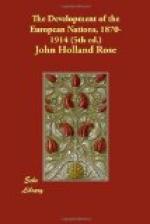[Footnote 486: See an article by Mr. J.M. Price in The Fortnightly Review for May 1905.]
Other parts of the track have also presented great difficulties. East of Lake Baikal the line gradually winds its way up to a plateau some 3000 feet higher than the lake, and then descends to treacherous marsh lands. The district of the Amur bristles with obstacles, not the least being the terrible floods that now and again (as in 1897) turn the whole valley into a trough of swirling waters[487].
[Footnote 487: Russia on the Pacific, by “Vladimir”; The Awakening of the East, by P. Leroy-Beaulieu, chaps, ix. x.]
All these difficulties have been overcome in course of time; but there remained the question of the terminus. Up to the year 1894 the objective had been Vladivostok; but the outbreak of the Chino-Japanese War at that time opened up vast possibilities. Russia could either side with the islanders and share with them the spoils of Northern China, or, posing as the patron of the celestials, claim some profitable douceurs as her reward.
She chose the latter alternative, and, in the opinion of some of her own writers, wrongly. The war proved the daring, the patriotism, and the organising skill of the Japanese to be as signal as the sloth and corruptibility of their foes. Then, for the first time, the world saw the utter weakness of China—a fact which several observers (including Lord Curzon) had vainly striven to make clear. Even so, when Chinese generals and armies took to their heels at the slightest provocation; when their battleships were worsted by Japanese armoured cruisers; when their great stronghold, Port Arthur, was stormed with a loss of about 400 killed, the moral of it all was hidden from the wise men of the West. Patronising things were said of the Japanese as conquerors—of the Chinese; but few persons realised that a new Power had arisen. It seemed the easiest of undertakings to despoil the “venomous dwarfs” of the fruits of their triumph over China[488].
[Footnote 488: See the evidence adduced by V. Chirol, The Far Eastern Question, chap, xi., as to the ultimately aggressive designs of China on Japan.]
The chief conditions of the Chino-Japanese Treaty of Shimonoseki (April 17, 1895) were the handing over to Japan the island of Formosa and the Liaotung Peninsula. The latter was very valuable, inasmuch as it contained good ice-free harbours which dominated the Yellow Sea and the Gulf of Pechili; and herein must be sought the reason for the action of Russia at this crisis. Li Hung Chang, the Chinese negotiator, had already been bought over by Russia in an important matter[489], and he early disclosed the secret of the terms of peace with Japan. Russia was thus forewarned; and, before the treaty was ratified at Pekin, her Government, acting in concert with those of France and Germany, intervened with a menacing declaration




